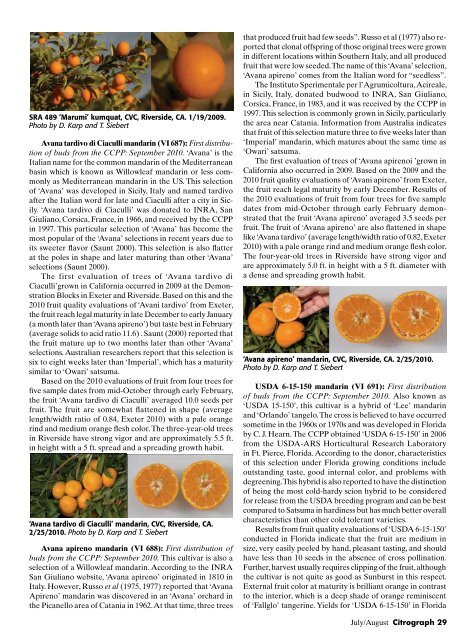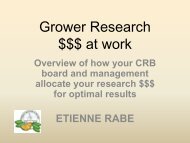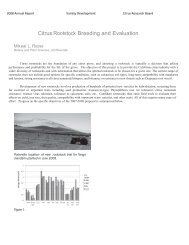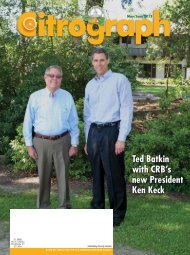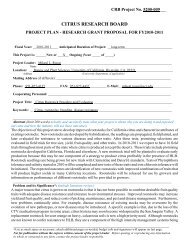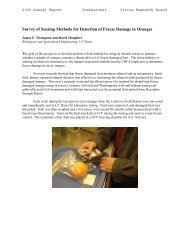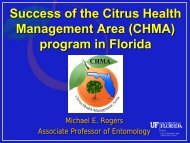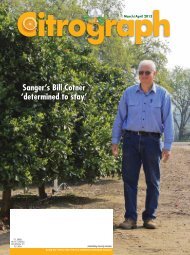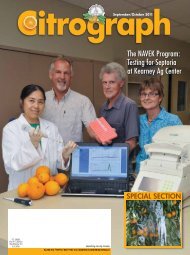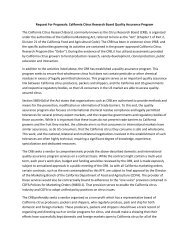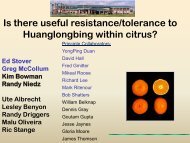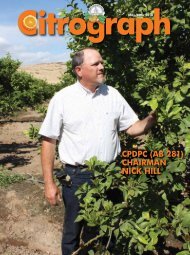Beth Grafton-Cardwell and her team at Lindcove - Citrus Research ...
Beth Grafton-Cardwell and her team at Lindcove - Citrus Research ...
Beth Grafton-Cardwell and her team at Lindcove - Citrus Research ...
Create successful ePaper yourself
Turn your PDF publications into a flip-book with our unique Google optimized e-Paper software.
SRA 489 ‘Marumi’ kumqu<strong>at</strong>, CVC, Riverside, CA. 1/19/2009.<br />
Photo by D. Karp <strong>and</strong> T. Siebert<br />
Avana tardivo di Ciaculli m<strong>and</strong>arin (VI 687): First distribution<br />
of buds from the CCPP: September 2010. ‘Avana’ is the<br />
Italian name for the common m<strong>and</strong>arin of the Mediterranean<br />
basin which is known as Willowleaf m<strong>and</strong>arin or less commonly<br />
as Mediterranean m<strong>and</strong>arin in the US. This selection<br />
of ‘Avana’ was developed in Sicily, Italy <strong>and</strong> named tardivo<br />
after the Italian word for l<strong>at</strong>e <strong>and</strong> Ciaculli after a city in Sicily.<br />
‘Avana tardivo di Ciaculli’ was don<strong>at</strong>ed to INRA, San<br />
Giuliano, Corsica, France, in 1966, <strong>and</strong> received by the CCPP<br />
in 1997. This particular selection of ‘Avana’ has become the<br />
most popular of the ‘Avana’ selections in recent years due to<br />
its sweeter flavor (Saunt 2000). This selection is also fl<strong>at</strong>ter<br />
<strong>at</strong> the poles in shape <strong>and</strong> l<strong>at</strong>er m<strong>at</strong>uring than ot<strong>her</strong> ‘Avana’<br />
selections (Saunt 2000).<br />
The first evalu<strong>at</strong>ion of trees of ‘Avana tardivo di<br />
Ciaculli’grown in California occurred in 2009 <strong>at</strong> the Demonstr<strong>at</strong>ion<br />
Blocks in Exeter <strong>and</strong> Riverside. Based on this <strong>and</strong> the<br />
2010 fruit quality evalu<strong>at</strong>ions of ‘Avani tardivo’ from Exeter,<br />
the fruit reach legal m<strong>at</strong>urity in l<strong>at</strong>e December to early January<br />
(a month l<strong>at</strong>er than ‘Avana apireno’) but taste best in February<br />
(average solids to acid r<strong>at</strong>io 11.6) . Saunt (2000) reported th<strong>at</strong><br />
the fruit m<strong>at</strong>ure up to two months l<strong>at</strong>er than ot<strong>her</strong> ‘Avana’<br />
selections. Australian researc<strong>her</strong>s report th<strong>at</strong> this selection is<br />
six to eight weeks l<strong>at</strong>er than ‘Imperial’, which has a m<strong>at</strong>urity<br />
similar to ‘Owari’ s<strong>at</strong>suma.<br />
Based on the 2010 evalu<strong>at</strong>ions of fruit from four trees for<br />
five sample d<strong>at</strong>es from mid-October through early February,<br />
the fruit ‘Avana tardivo di Ciaculli’ averaged 10.0 seeds per<br />
fruit. The fruit are somewh<strong>at</strong> fl<strong>at</strong>tened in shape (average<br />
length/width r<strong>at</strong>io of 0.84, Exeter 2010) with a pale orange<br />
rind <strong>and</strong> medium orange flesh color. The three-year-old trees<br />
in Riverside have strong vigor <strong>and</strong> are approxim<strong>at</strong>ely 5.5 ft.<br />
in height with a 5 ft. spread <strong>and</strong> a spreading growth habit.<br />
‘<br />
‘Avana tardivo di Ciaculli’ m<strong>and</strong>arin, CVC, Riverside, CA.<br />
2/25/2010. Photo by D. Karp <strong>and</strong> T. Siebert<br />
Avana apireno m<strong>and</strong>arin (VI 688): First distribution of<br />
buds from the CCPP: September 2010. This cultivar is also a<br />
selection of a Willowleaf m<strong>and</strong>arin. According to the INRA<br />
San Giuliano website, ‘Avana apireno’ origin<strong>at</strong>ed in 1810 in<br />
Italy. However, Russo et al (1975, 1977) reported th<strong>at</strong> ‘Avana<br />
Apireno’ m<strong>and</strong>arin was discovered in an ‘Avana’ orchard in<br />
the Picanello area of C<strong>at</strong>ania in 1962. At th<strong>at</strong> time, three trees<br />
th<strong>at</strong> produced fruit had few seeds”. Russo et al (1977) also reported<br />
th<strong>at</strong> clonal offspring of those original trees were grown<br />
in different loc<strong>at</strong>ions within Sout<strong>her</strong>n Italy, <strong>and</strong> all produced<br />
fruit th<strong>at</strong> were low seeded. The name of this ‘Avana’ selection,<br />
‘Avana apireno’ comes from the Italian word for “seedless”.<br />
The Instituto Sperimentale per l’Agrumicoltura, Acireale,<br />
in Sicily, Italy, don<strong>at</strong>ed budwood to INRA, San Giuliano,<br />
Corsica, France, in 1983, <strong>and</strong> it was received by the CCPP in<br />
1997. This selection is commonly grown in Sicily, particularly<br />
the area near C<strong>at</strong>ania. Inform<strong>at</strong>ion from Australia indic<strong>at</strong>es<br />
th<strong>at</strong> fruit of this selection m<strong>at</strong>ure three to five weeks l<strong>at</strong>er than<br />
‘Imperial’ m<strong>and</strong>arin, which m<strong>at</strong>ures about the same time as<br />
‘Owari’ s<strong>at</strong>suma.<br />
The first evalu<strong>at</strong>ion of trees of ‘Avana apirenoi ’grown in<br />
California also occurred in 2009. Based on the 2009 <strong>and</strong> the<br />
2010 fruit quality evalu<strong>at</strong>ions of ‘Avani apireno’ from Exeter,<br />
the fruit reach legal m<strong>at</strong>urity by early December. Results of<br />
the 2010 evalu<strong>at</strong>ions of fruit from four trees for five sample<br />
d<strong>at</strong>es from mid-October through early February demonstr<strong>at</strong>ed<br />
th<strong>at</strong> the fruit ‘Avana apireno’ averaged 3.5 seeds per<br />
fruit. The fruit of ‘Avana apireno’ are also fl<strong>at</strong>tened in shape<br />
like ‘Avana tardivo’ (average length/width r<strong>at</strong>io of 0.82, Exeter<br />
2010) with a pale orange rind <strong>and</strong> medium orange flesh color.<br />
The four-year-old trees in Riverside have strong vigor <strong>and</strong><br />
are approxim<strong>at</strong>ely 5.0 ft. in height with a 5 ft. diameter with<br />
a dense <strong>and</strong> spreading growth habit.<br />
‘Avana apireno’ m<strong>and</strong>arin, CVC, Riverside, CA. 2/25/2010.<br />
Photo by D. Karp <strong>and</strong> T. Siebert<br />
USDA 6-15-150 m<strong>and</strong>arin (VI 691): First distribution<br />
of buds from the CCPP: September 2010. Also known as<br />
‘USDA 15-150’, this cultivar is a hybrid of ‘Lee’ m<strong>and</strong>arin<br />
<strong>and</strong> ‘Orl<strong>and</strong>o’ tangelo. The cross is believed to have occurred<br />
sometime in the 1960s or 1970s <strong>and</strong> was developed in Florida<br />
by C. J. Hearn. The CCPP obtained ‘USDA 6-15-150’ in 2006<br />
from the USDA-ARS Horticultural <strong>Research</strong> Labor<strong>at</strong>ory<br />
in Ft. Pierce, Florida. According to the donor, characteristics<br />
of this selection under Florida growing conditions include<br />
outst<strong>and</strong>ing taste, good internal color, <strong>and</strong> problems with<br />
degreening. This hybrid is also reported to have the distinction<br />
of being the most cold-hardy scion hybrid to be considered<br />
for release from the USDA breeding program <strong>and</strong> can be best<br />
compared to S<strong>at</strong>suma in hardiness but has much better overall<br />
characteristics than ot<strong>her</strong> cold tolerant varieties.<br />
Results from fruit quality evalu<strong>at</strong>ions of ‘USDA 6-15-150’<br />
conducted in Florida indic<strong>at</strong>e th<strong>at</strong> the fruit are medium in<br />
size, very easily peeled by h<strong>and</strong>, pleasant tasting, <strong>and</strong> should<br />
have less than 10 seeds in the absence of cross pollin<strong>at</strong>ion.<br />
Furt<strong>her</strong>, harvest usually requires clipping of the fruit, although<br />
the cultivar is not quite as good as Sunburst in this respect.<br />
External fruit color <strong>at</strong> m<strong>at</strong>urity is brilliant orange in contrast<br />
to the interior, which is a deep shade of orange reminiscent<br />
of ‘Fallglo’ tangerine. Yields for ‘USDA 6-15-150’ in Florida<br />
July/August Citrograph 29


